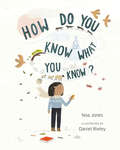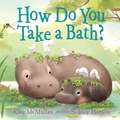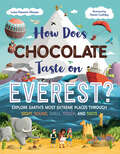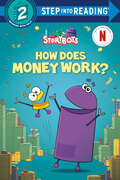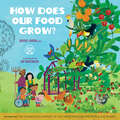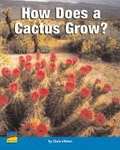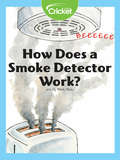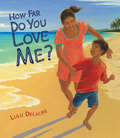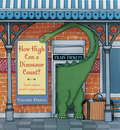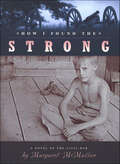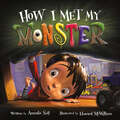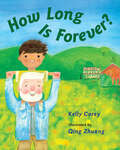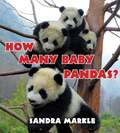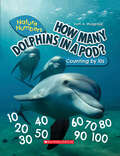- Table View
- List View
How Do You Know What You Know?
by Noa JonesA charming and inquisitive story that celebrates tracing the origin of ideas, language, and every day objects, for children 4–8.Where does snow come from? What language did the word thermos come from? And who was the Buddha's teacher?So many problems in the world come from accepting information at face value without looking into where it comes from. How Do You Know What You Know? follows a child and their father on a cozy, snowy day outing. The child asks questions about how things came to be the way they are. The questions range from how the father knows how to tie a shoe to why it&’s not a good idea to eat yellow snow. These queries are met by the father with patience and humor that weave a delightful narrative of intergenerational knowledge sharing. In this exchange, respectful inquiry is beautifully modeled for young learners.The journey includes an amble in the park, a trip to the library, a bus ride, and a visit to a local Buddhist temple where the father is a student. The teacher there introduces the child to the idea of lineage, that wisdom and understanding comes from generations of knowledge passed down from person to person. With a quaint and welcoming simplicity, the illustrations bring this beautiful story to life, and every spread has a subtle nod to the progression of how things come to be the way they are. The story encourages children&’s natural curiosity and shows them that everywhere they look there is a story to be told if we just ask.
How Do You Lift a Lion?
by Robert E WellsExplore the functions of levers, wheels, and pulleys, and learn how to lift a lion, pull a panda, and deliver a basket of bananas to a baboon birthday party!
How Do You Take a Bath?
by Kate McMullanPerfect for fans of Five Little Monkeys Jump in the Bath, this fun and educational picture book brings together adorable baby animals and bathtime.How do YOU take a bath? Does your mama comb your fur?Do you shake off all your dirt?Do you splash and flap and quack?Do the birdies peck your back?No!Follow elephants, pigs, monkeys, hippos, and more in this charming rhyming picture book from veteran author Kate McMullan. How does a pig take a bath? It sinks in the mud! What about a chicken? It thrashes about in dust! And a cat? Why, it licks itself clean, of course! Sydney Hanson's adorable illustrations toggle neatly between animals in nature grooming themselves and humorous depictions of children attempting the animals' bathing tactics. By the end of the book, the child finally makes his way to the bathtub, no mud baths or lick baths about it!
How Does Chocolate Taste on Everest?: Explore Earth's Most Extreme Places Through Sight, Sound, Smell, Touch, and Taste
by Leisa Stewart-SharpeAn immersive round-the-world adventure, where YOU are the explorer experiencing the most extreme places on earth and doing it all through your five senses.Have you ever wondered what the buzz of the rain forest sounds like on a trek through the Amazon? Or how it feels to experience the biting cold as you voyage across Antarctica? Or how chocolate tastes on Mount Everest? From every heart-bursting sight to tummy-lurching smell, you will experience them all–and do so without having to leave the comforts of your couch.This funny and fast-paced interactive thrill ride that young adventure-seekers are sure to enjoy is chock-full of facts, history, and survival tips peppered on every page.
How Does Money Work? (Step into Reading)
by Scott EmmonsThe robots from Netflix's StoryBots Answer Time star in an all-new Step 2 Step into Reading leveled reader!Bing wants to know what money is and why we use it. His questions lead him from a bank to a tour of a successful lemonade stand. What he learns will fascinate children ages 4 to 6 who love Netflix's educational show.Step 2 Readers use basic vocabulary and short sentences to tell simple stories. For children who recognize familiar words and can sound out new words with help.
How Does Our Food Grow
by Brooke JordenFruits and vegetables all taste great, but how did they end up on your plate? The fresh and colorful foods you know came from farms—that&’s where they grow! Some grow underground and some hang from trees. Can you find them all? Let&’s look and see! Every fruit, vegetable, grain, and legume has its own story: Where do they grow? How do they taste? And how do they impact our bodies and the world around us? In cooperation with Kitchen Connection, an organization committed to improving our food system through education, this colorful picture book introduces readers to the concepts of biodiversity, reducing food waste, and proper growing conditions for different crops in simple, accessible language. With cool facts and challenges throughout, fun rhyming verse, and charming illustrations, How Does Our Food Grow? tells the stories of more than a dozen of your favorite fresh foods. Knowing that our food choices make a difference in our health and the health of our planet empowers us to choose wisely. The more we know, the better we grow.
How Does a Cactus Grow?
by Vicki Rushworth David Haggerty Clare O’brienIn this book, learn how cacti grow from seeds and survive in the harsh desert environment.
How Does a Smoke Detector Work?
by Liz HuyckEver wonder why a smoke alarm goes off? A battery, siren, and metal can work together to detect smoke and sound the alarm when catching a whiff of smoke.
How Elephant Made Peanut Butter
by Lori O'Dea Marcin Piwowarski Lesli FavorHow can an elephant feed his friends? The forest animals gather for lunch, but no one has any food. Can Elephant get them to try his idea?
How Far Do You Love Me?
by Lulu DelacreThis unique bedtime book by award-winning author-illustrator Lulu Delacre features a game that highlights the universal love between caregivers and children while taking readers on a journey across the seven continents of Earth.How far do you love me?I love you to the top of the peakslit by the morning sun ...To the crests of the desert where the wind sweeps sand from the dunes ... Based on a bedtime game that author-illustrator Lulu Delacre played with her young daughters, How Far Do You Love Me? is an "I love you" book with a twist. With every expression of love, readers visit a different location around the world, each a beautifully illustrated scene of caregivers and children in a place of natural beauty. The intimate size of the book is just right for sharing and snuggling up close with a child. As bedtime--or any quiet time--approaches, gather close with a special person in your life and get ready to let your imagination soar to place after place as you embark on a game of "How far do you love me?" The possibilities are endless!
How Frogs Grow (Fountas & Pinnell LLI Green #Level G, Lesson 79)
by Stanley FrancisFountas and Pinnell Leveled Literacy Intervention Green System -- 1st Grade
How Garbage Gets from Trash Cans to Landfills (Here To There Ser.)
by Erika L. Shoresrecycling; homes; utilities; community helpers; garbage collectors; garbage trucks
How Gliders Fly (Into Reading, Level J #52)
by Heather HammondsNIMAC-sourced textbook <p><p> A non-fiction explanation about non-engine powered objects that can fly: will tell readers how some non-engine powered objects fly. Text type: explanation; Genre: non-fiction
How High Can a Dinosaur Count?: ...and Other Math Mysteries
by Valorie FisherBelieve it or not, once Bessie balanced a tower of 8 beets. But today, when she tries to balance 8 beets . . . 3 fall. How many beets does Bessie balance today?A clever text and imaginative art mesh to create playful, simple math problems right on target for ages 5-99 . . . anyone who loves the magic of numbers! In this School Library Journal Best Book of the Year, budding young mathematicians can help Heloise add her dimes, nickels, and pennies to see which hat in Madame Millie's Hat Shop she can buy. Or they can tell time with Lulu at the Tutti-Frutti Zoo, where Lollipop Licking begins at 9:00 sharp.From the Hardcover edition.
How I Found the Strong
by Margaret McMullanIt is the spring of 1861, and the serenity of Smith County, Mississippi, has been shattered by Abraham Lincoln’s declaration of war on the South. Young and old are taking up arms and marching off to war. But not ten-year-old Frank Russell. Although he is eager to enlist in the Confederate army, he is not allowed. He is too young, too skinny, too weak. After all, he’s just “Shanks,” the baby of the Russell family. War has a way of taking things away from a person, mercilessly. And this war takes from Frank a mighty sum. It’s nabbed his Pa and older brother. It’s stolen his grandfather, his grandmother. It has robbed Frank of a simpler way of life, food, his boyhood. And gone are his idealistic dreams of heroic battles and hard-fought victories. Now all that replaces those images are questions: Will I ever see my father and brother again? Why are we fighting this war? Are we fighting for the wrong reasons? Will things ever be the same around here?
How I Met My Monster (I Need My Monster)
by Amanda NollOne night, when Ethan reaches under his bed for a toy truck, he finds this note instead: "Monsters! Meet here for final test." Ethan is sure his parents are trying to trick him into staying under the covers, until he sees five colorful sets of eyes blinking at him from beneath the bed. Soon, a colorful parade of quirky, squeaky little monsters compete to become Ethan's monster. But only the little green monster, Gabe, has the perfect blend of stomach-rumbling and snorting needed to get Ethan into bed and keep him there so he falls asleep—which as everyone knows, is the real reason for monsters under beds. With its perfect balance of giggles and shivers, this silly-spooky prequel to the award-winning I Need My Monster and Hey, That's MY Monster! will keep young readers entertained.
How I Spent My Summer Vacation
by Mark TeagueSome kids spend their summer vacation at camp. Some kids spend it at Grandma's house. Wallace Bleff spent his out west...on a ride, a rope, and a roundup he'll never forget.
How I Started a Clothing Drive
by Jeffrey B. Fuerst Max Francis Rina KrevatThe weather is turning cold. Max wants everyone to have something warm to wear. He sets out to make his idea happen. Will his plan work?
How Is a Crayon Made?
by Oz CharlesEver wonder how crayons are made? Find out about all the steps that go into making your favorite crayons in this book!
How Long Is Forever?
by Kelly CareyFans of Guess How Much I Love You will love figuring out how long forever is alongside Mason and Grandpa.Mason is waiting for Nana's blueberry pie and complains that it's taking forever. So Grandpa challenges him to figure out how long forever really is. Is it as long as Grandpa has had his tractor? No. As long as it took Nana to grow the roses to the top of the chimney? Not even close. After a trip around the farm to figure out the answer, Nana's pie is ready. And Mason's finally got the answer: forever is how long he'll love Nana's pie and how long he'll love Nana and Grandpa, too.
How Long Is a Month? (The\calendar Ser.)
by Claire ClarkA lot happens in a month! As the moon makes one trip around Earth, plants grow and you do too. Find out more in How Long Is a Month?
How Many Baby Pandas?
by Sandra MarkleBaby pandas abound as readers learn how they live and grow. Science expert Sandra Markle bumps up the cuteness factor in this adorable photo essay featuring the eight panda pairs that were born during a baby boom at China's Wolong Giant Panda Breeding and Research Center in 2005. Basic counting skills combine with panda facts to introduce readers to numbers and these cuddly cubs, from the moment they were born to the time they started climbing trees. Tracked as they play and grow in captivity, until they are strong enough to be released into the wild, these baby pandas will steal any reader's heart, whether it's one at a time or sixteen at once!
How Many Dolphins In a Pod?: Counting By 10's (Nature Numbers)
by Ruth MusgraveIn Nature Numbers, math is beautiful, recognizable, and all around us! Highly engaging pictures of animals and nature scenes, along with cool chalk illustrations, are used to introduce basic math concepts and encourage kids to see a world of numbers all around them.K-2 math concepts include power of 10. This book encourages kids to learn about multiples of 10 as schools of fish swim by and coral polyps build reefs, all with amazing nature pictures and chalk illustrations!
